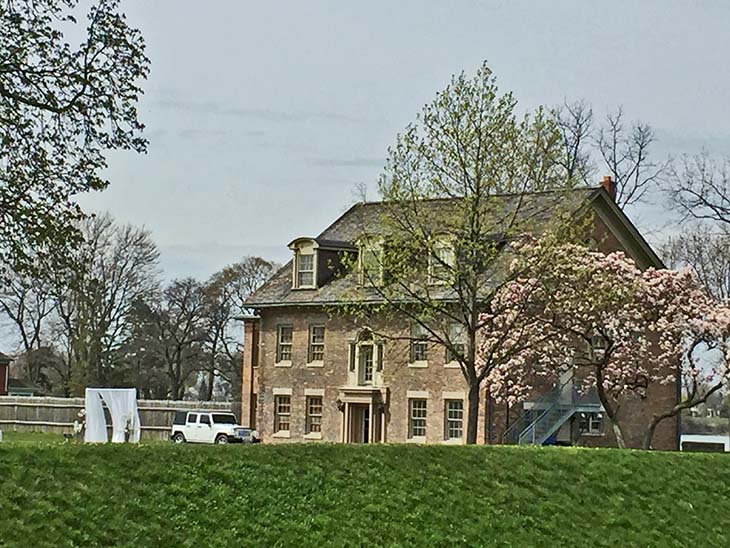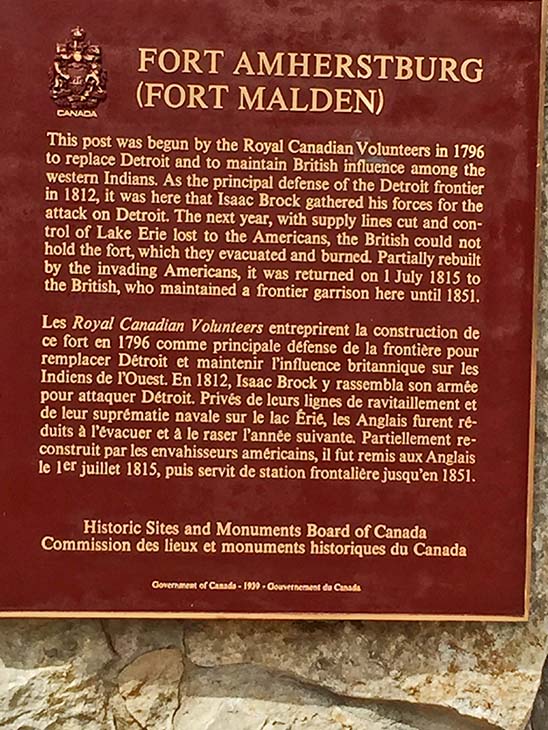


In September, 1859, British forces defeated French forces in the Battle of Québec, effectively terminating the French Empire in North America. The British defeated the French once again the next year in fighting near Montréal. On November 29, 1860, British regulars dispatched from Fort Pitt arrived in Detroit and the French peacefully gave up their control of Fort Pontchartrain. The British then established a military base at Detroit and called it Fort Lernoult. It was name for the British Major who superintended the construction of the British fort that replaced the French Fort Pontchartrain. This is the fortress that Chief Pontiac and his allies sought to take over when he laid siege to Detroit on May 10, 1763. On October 31 of that year, Chief Pontiac gave up his attempts to take over Detroit, thanks to the defense established by Major Gladwin and his British troops.
The British continued to occupy Detroit after the American Revolution. In August, 1794, American forces led by General Anthony Wayne defeated Indians who were supported by the British on the banks of the Maumee. The following year, the United States and Britain signed Jay's Treaty giving control of the current Great Lakes states to the United States. On July 13, Colonel Jean François Hamtramck led 400 United States troops to Detroit and peacefully took over the British fort. It was renamed Fort Detroit, but after the War of 1812, it was renamed Fort Shelby to honor the Kentucky governor who recruited many volunteers for that military campaign.
led 400 United States troops to Detroit and peacefully took over the British fort. It was renamed Fort Detroit, but after the War of 1812, it was renamed Fort Shelby to honor the Kentucky governor who recruited many volunteers for that military campaign.
After evacuating Detroit, a fort was established in or near present-day Amherstburg. I do not know the exact details of its founding. I have read that the British may have established a military presence near the mouth of the Detroit River on the shores of Lake Erie. I have also read that Canadian forces or volunteers established something of a fort at Amherstburg to provide a defense against Indians who might resume the military activities Chief Pontiac began. Whatever its origin, there was a military outpost here by 1812.
President Madison wished to initiate a war against Britain in early 1812. The British claimed the right to superintend US trade with European counties by demanding that captains of US bottoms either stop in England or obtain some type of permission before entering European countries. The British Navy and, apparently, British merchant ships frequently stopped US bottoms and pressed their crews into service on British ships. The British argued that person born in the colonies before the American Revolution were British citizens and could be forced to serve in the Royal Navy. President Madison assumed that United States forces, in the summer of 1812, could easily invade and conquer a weakly defended Canada by entering from northern New York State near Montréal, at the Niagara Frontier and through Detroit. I believe he assumed that the US troops invading from Detroit and present-day Buffalo would meet little opposition and could easily march across southern Ontario giving the United States firm control of that component of the British Empire. Madison knew that England’s armed forces were seriously engaged in the Napoleonic Wars in Europe so they could not easily send thousands of troops to defend Canada.
There was strong opposition to this war since New England and East Coast merchants were greatly profiting from international trade. The Senate, however, approved the war by one vote on June 18, 1812. Then troubles began. Presidents Washington and Jefferson had not invested heavily in developing a modern army and navy. Most of the US officers in 1812 were former Revolutionary Army officers now getting to their mature ages. The US military quickly discovered they did not have the resources to invade Canada through the Niagara Frontier in the summer of 1812. President Madison could not find a capable military leader for the western army and, reluctantly, turned command over the forces in Detroit Theater to Michigan Territorial Governor William Hull who had served in the Revolutionary Army.
Hull had few, if any, troops to command in Michigan, but Governor Shelby of Kentucky was successfully recruiting men to fight the British. In the late spring of 1812, Hull went to southern Ohio and began assembling an army, one that lacked most basic supplies and the necessary equipment. Apparently, volunteers were expected to bring their own rifles and equipment. He faced a great problem in getting his forces to Detroit since Ohio was covered with very wet marshes. He spent about six weeks building passable roads in a zig-zag fashion north from the Dayton area to Toledo seeking dry ground wherever he could find it. Along the way, he established five forts and left personnel at each to protect his supply lines against possible attracts from Indians supplied by the British.
Communication was not easily accomplished in that era. British forces in Ontario learned from British intelligence that the United States had declared war in mid-June, 1812. General Brook prepared for an invasion, but then learned that the United States' military would not invade by crossing the Niagara. He led his forces to the military outpost at Amherstburg. In late June, 1812, General Hull reached Toledo with his troops and thought it would be ideal to get some of his forces and material to Detroit rapidly by boat since he knew roads would have to be built from the mouth of the Maumee to Detroit. He did not know that the United States had declared war against the British. He dispatched the ship Cuyahoga north from Toledo to Detroit. When the ship sailed close to Amherstburg, the British seized it and were alerted to the invasion threat they faced. Apparently while Hull was in the site of present day Toledo, a messenger arrived from Washington to tell him that the nation was at war and he was to invade Canada.

General Hull reached Detroit on July 6, 1812 with about 400 regulars, 1,450 volunteers from Kentucky and Ohio and 200 from Michigan territory. Following his orders, Hull sent men into Canada on July 16. They engaged in a few small skirmishes with British forces from Amherstburg and retreated to Detroit on August 2. Apparently, Hull’s junior officers concluded that whenever there was fire, Hull advocated retreat. Believing that Detroit was surrounded by numerous British troops and their Indian allies who would destroy the village just as it had burned to the ground in June, 1805, General Hull surrendered Detroit on August 16 without firing a shot. For this he was court martialed and ordered to be hanged. President Madison eventually commuted his sentence. William Hull spent a great deal of his remaining years trying to clear his name.
Fort Malden is a very attractive national park, one of the most scenic in the Detroit area. The park commemorates the effective way in which the British and their Indian and Canadien allies defeated the United States forces when they invaded Canada in July, 1812. Less information is provided about the next year’s events. On September 10, 1813 United States naval forces defeated the seemingly invincible British Navy in the famous Battle of Lake Erie. Following that defeat, forces led by General and future President William Henry Harrison peacefully took Detroit from the British. The English knew that Harrison would invade Canada in an effort to destroy the British troops and seal a US victory in the Detroit theatre. The British burned Fort Malden before they retreated to the east. They did not get far. On October 5, 1812; U. S. forces, at the Battle of the Themes, defeated British and Indian troops led by General Proctor and Chief Tecumseh who was killed in the fighting. This ended fighting in the War of 1812 in the Lake Erie and Detroit area.
The War of 1812, which was basically a military stalemate, was ended when the United States and Britain agreed to the Treaty of Ghent on December 24 1814. The British ceased impressing US sailors and the US ceased its military offensive in Canada. The British returned to Fort Malden in 1815, built a small fort which was used by British and Canadien military forces until 1851. In the 1840s, the United States and Britain disputed many issues about the northern border of the United States. The anger was so strong that the state of Maine declared war against England and Congress built massive Fort Wayne in Detroit. Then the United States and England agreed to the Webster-Ashburn Treaty and, since then, the two nations have been at peace. That peace explains why the British abandoned Fort Malden.
Many local residents were greatly upset by the loss of revenue and insisted it be done. Apparently, the provincial and national authorities agreed that the former fort should be converted into a home or residential area for retired military personnel who would be obligated to provide public service if they resided there. As a result, from 1851 to 1858, the former fort served as a residential site for “enrolled pensioners.” I infer this did not work out very well. In the late 1850s, civic authorities decided that the former fort would make an ideal home for the mentally infirm. The change was made but there were, apparently, many charges of mismanagement and corruption and the fort’s use as a mental facility came to an end in 1870. The abandoned fort fell into disrepair and some parts of it were sold. In 1921, Amherstburg promoters thought that the site should be converted into a National Historic Park supported by the federal government. In a remarkably short 16 years—short in bureaucratic time—the government in Ottawa agreed and began investing in the site. I believe that there are no extant buildings that survive from the era when Fort Malden was a military outpost although some of the more recently constructed buildings may be built on original foundation. The fort is a spectacularly attractive location and provides much information about what it may have been like to serve in the British and Canadien military before and after the War of 1812 and during the late 1830s when some individuals from both sides of the border promoted the idea of a rebellion to free Ontario from English rule.
National Historic Sites of Canada: Fort Malden is one of 168 National Historic Sites. The nearby Bois Blanc Island Lighthouse and Blockhouse is also a National Historic Site.
Photograph: Ren Farley; April 30, 2016
Description prepared: May, 2016
Return to Military Sites
Return to War of 1812 Sites
Return to Homepage